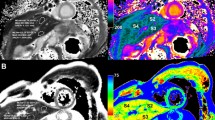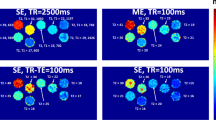Abstract
Background: Fat-suppressed T2-weighted gradient and spin echo (GRASE) magnetic resonance imaging in the liver was compared with three other sequences: conventional spin echo (SE), fat-suppressed and respiratory-triggered turbo SE (TSE), and fast field echo (FFE).
Methods: All sequences were applied in 48 prospective patients. Quantitative and qualitative analyses were performed. Biopsy or clinical follow-up established the final diagnosis of the lesions.
Results: GRASE showed the second best contrast-to-noise ratio, the second best artifact level, the same lesion detectability as TSE, and very short acquisition time. GRASE and TSE had the highest sensitivity, specificity, and accuracy.
Conclusion: Fat-suppressed GRASE offers a fast and accurate method for imaging the liver.
Similar content being viewed by others
Author information
Authors and Affiliations
Additional information
Received: 28 February 2000/Revision accepted: 14 June 2000
Rights and permissions
About this article
Cite this article
Karantanas, A., Papanikolaou, N. T2-weighted magnetic resonance imaging of the liver: comparison of fat-suppressed GRASE with conventional spin echo, fat-suppressed turbo spin echo, and gradient echo at 1.0 T. Abdom Imaging 26, 139–145 (2001). https://doi.org/10.1007/s002610000126
Published:
Issue Date:
DOI: https://doi.org/10.1007/s002610000126




